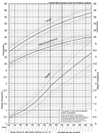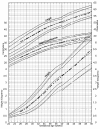A new growth chart for preterm babies: Babson and Benda's chart updated with recent data and a new format
- PMID: 14678563
- PMCID: PMC324406
- DOI: 10.1186/1471-2431-3-13
A new growth chart for preterm babies: Babson and Benda's chart updated with recent data and a new format
Abstract
Background: The Babson and Benda 1976 "fetal-infant growth graph" for preterm infants is commonly used in neonatal intensive care. Its limits include the small sample size which provides low confidence in the extremes of the data, the 26 weeks start and the 500 gram graph increments. The purpose of this study was to develop an updated growth chart beginning at 22 weeks based on a meta-analysis of published reference studies.
Methods: The literature was searched from 1980 to 2002 for more recent data to complete the pre and post term sections of the chart. Data were selected from population studies with large sample sizes. Comparisons were made between the new chart and the Babson and Benda graph. To validate the growth chart the growth results from the National Institute of Child Health and Human Development Neonatal Research Network (NICHD) were superimposed on the new chart.
Results: The new data produced curves that generally followed patterns similar to the old growth graph. Mean differences between the curves of the two charts reached statistical significance after term. Babson's 10th percentiles fell between the new data percentiles: the 5th to 17th for weight, the 5th and 15th for head circumference, and the 6th and 16th for length. The growth patterns of the NICHD infants deviated away from the curves of the chart in the first weeks after birth. When the infants reached an average weight of 2 kilograms, those with a birthweight in the range of 700 to 1000 grams had achieved greater than the 10th percentile on average for head growth, but remained below the 3rd percentile for weight and length.
Conclusion: The updated growth chart allows a comparison of an infant's growth first with the fetus as early as 22 weeks and then with the term infant to 10 weeks. Comparison of the size of the NICHD infants at a weight of 2 kilograms provides evidence that on average preterm infants are growth retarded with respect to weight and length while their head size has caught up to birth percentiles. As with all meta-analyses, the validity of this growth chart is limited by the heterogeneity of the data sources. Further validation is needed to illustrate the growth patterns of preterm infants to older ages.
Figures




References
-
- Babson SG, Benda GI. Growth graphs for the clinical assessment of infants of varying gestational age. J Pediatr. 1976;89:814–820. - PubMed
-
- KF Catrine. Anthropometric Assessment. In: Groh-Wargo S, Thompson M and Hovasi-Cox J, editor. Nutritional Care for High Risk Newborns . 3rd. Chicago, Precept Press; 2000.
-
- DM Anderson. Nutrition for the low-birth-weight infant. In: Mahan LK and Escott-Stump S, editor. Krause's Food,Nutrition and Diet Therapy. 10th. Philadelphia, WB Saunders; 2000. p. 231.
-
- Lubchenco LO, Hansman C, Boyd E. Intrauterine growth in length and head circumference as estimated from live births at gestational ages from 26 to 42 weeks. Pediatrics. 1966;37:403–408. - PubMed
-
- Dancis J, O'Connell JR, Holt LE. A grid for recording the weight of premature infants. J Pediatr. 1948;33:570–572. - PubMed
MeSH terms
LinkOut - more resources
Full Text Sources
Medical
Research Materials

